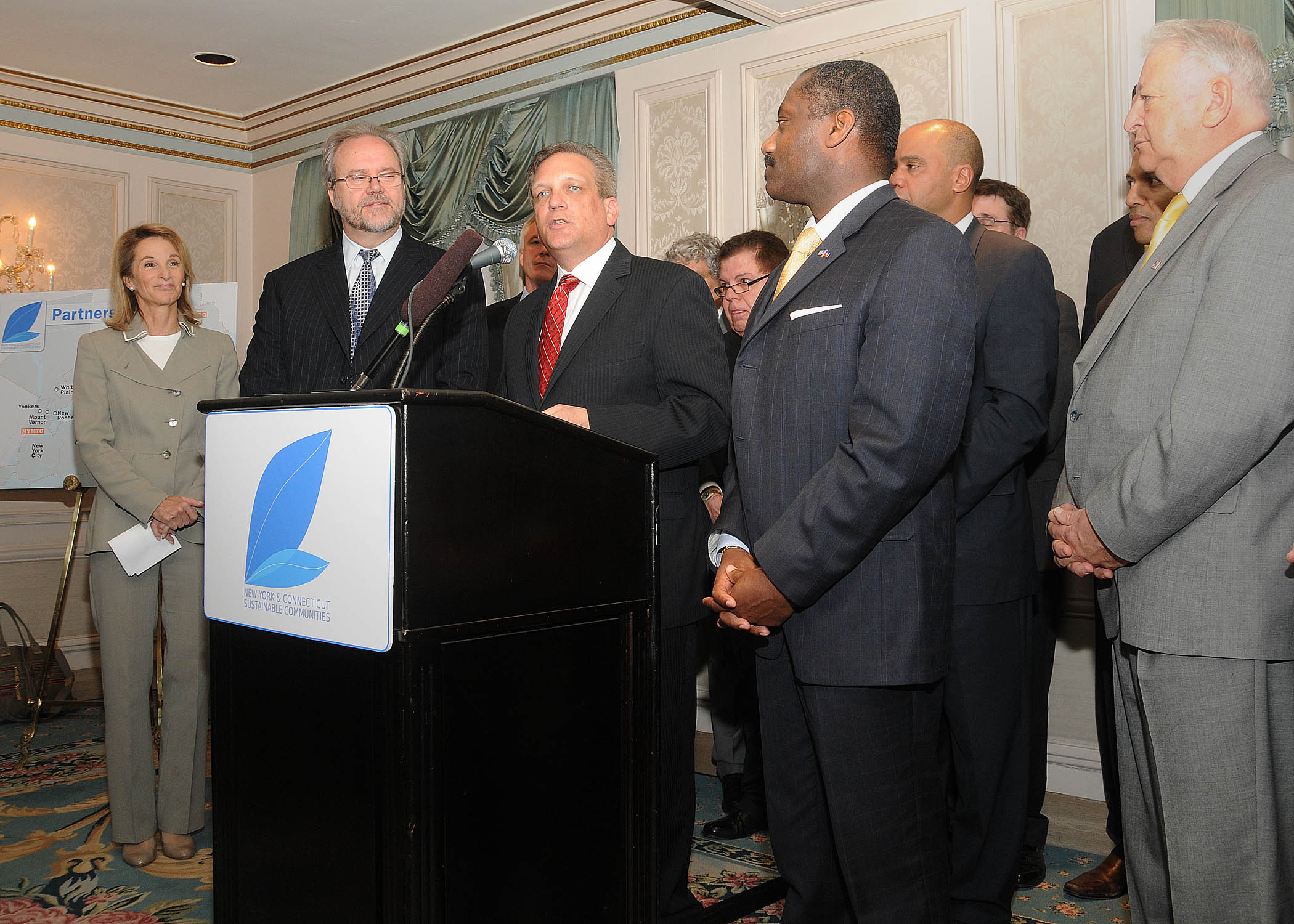Mangano, HUD, New York/Connecticut Mayors, Regional Planning Organziations Announce Unprecedented Bi-State Sustainability Collaboration

$3.5 Million Grant to Fund New Initiative
Nassau County Executive Edward P. Mangano was joined today by U.S. Department of Housing and Urban Development (HUD) Regional Administrator Adolfo Carrion, representatives from New York and Connecticut cities, New York City Planning Commissioner Amanda Burden and six regional planning organizations to kickoff of the New York-Connecticut Sustainable Communities initiative, an unprecedented bi-state collaboration that is the recipient of a $3.5 million HUD Sustainable Communities Initiative Grant.
By developing livable communities and growth centers around the region’s transit network, the New York-Connecticut Sustainable Communities initiative seeks to expand economic opportunity by creating and connecting residents to jobs; fostering new affordable, energy-efficient housing; providing more transportation choices; strengthening existing communities; and making the region more globally competitive. The grant will be administered by Regional Plan Association, a non-profit regional planning organization. For more information on the initiative, log on to www.sustainableNYCT.org.
“This collaborative effort will help our region enhance affordable housing efforts, reduce congestion, improve the environment and expand economic opportunities so that residents can be put back to work,” said Nassau County Executive Edward P. Mangano. “On Long Island, undeveloped land around railroad stations and existing downtowns provide an opportunity for a new model of suburban growth that both protects existing neighborhoods and open space while generating job opportunities.”
The goal of the Consortium is to reposition the New York-Connecticut region to fully harness its innovation capabilities in a competitive global environment, build on its strong foundation of energy efficiency, and become as equitable as it is efficient. Its primary focus is to leverage the most extensive and robust transit system in the nation by developing livable communities with mixed-income housing and employment at key nodes in the MTA Metro-North Railroad and MTA Long Island Rail Road network.
Activities that will be undertaken include large-scale transit-oriented development and neighborhood sustainability projects at key nodes in the MTA Metro-North Railroad and MTA Long Island Rail Road commuter rail systems, strategies to advance climate resilience, open space protection and access to affordable housing, and enhancements to existing regional sustainability plans. A description of individual projects is attached.
Consortium members include the cities of New York, New Haven, Bridgeport, Norwalk, Stamford, Yonkers, White Plains, New Rochelle, and Mount Vernon; Nassau and Suffolk counties; the New York Metropolitan Transportation Council (NYMTC), South Western Regional Metropolitan Planning Organization (SWRMPO), Greater Bridgeport/Valley Metropolitan Planning, Organization (GBVMPO), South Central Regional Council of Governments (SCRCOG); and the Long Island Regional Planning Council (LIRPC) and Regional Plan Association (RPA).
An Advisory Board will initially consist of eleven state agencies and non-profit organizations, including the Connecticut Housing Finance Agency; Connecticut Department of Economic and Community Development; New York State Department of State; New York State Homes & Community Renewal; the Empire State Development Corporation; Local Initiatives Support Corporation; Urban Land Institute; International Council for Local Environmental Initiatives; WE ACT for Environmental Justice; the One Region Funders Group; and the North Jersey Transportation Planning Authority.
“I look forward to working with the New York-Connecticut Sustainable Communities initiative to advance smart growth in the New York Metro-area”, said HUD Regional Administrator Adolfo Carrión. “The President’s vision of a bottom-up model for federal investment, which began when I first undertook a listening tour with the White House Office of Urban Affairs, is now finally going to be realized. The President, the HUD Secretary and our agency, as well as our federal elected representatives will have a locally-created regional blueprint for investing federal resources that will advance economic competitiveness, environmental responsibility and quality communities. Congratulations to the Consortium…I look forward to seeing the benefits of their hard work in planning the region’s future.”
The $3.5 million grant is part of HUD's new Sustainable Communities Regional Planning Grant Program to support more livable and sustainable communities across the country. The grants, totaling $100 million, will support State, local, and tribal governments, as well as metropolitan planning organizations, in the development and execution of regional plans intended to build economic competitiveness by connecting housing with good jobs, quality schools and transportation. The grants are part of the Obama Administration’s Partnership for Sustainable Communities, which brings EPA, HUD, USDA and USDOT together to ensure the agencies’ policies, programs, and funding consider affordable housing, transportation and environmental protection together.

